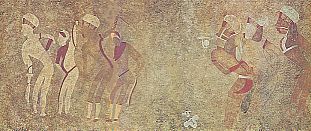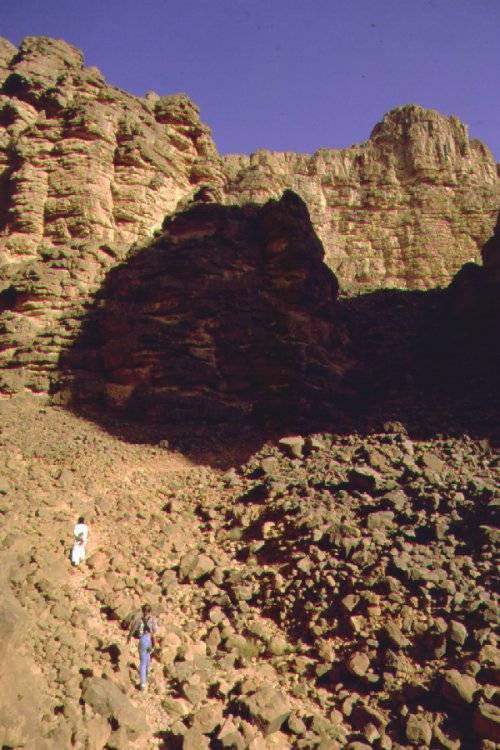Xenophon
Gone and forgotten
Because nobody asked for it, yet another story to pass the time and maybe teach a bit of history with..
A caravan of Tuareg nomads silently led their camels into a camping ground on a stoney plateau in the Sahara. With them was a young German explorer, Heinrich Barth, on his way to lake Chad.
Glancing around at the steep sandstone cliffs that hemmed them in, Barth saw with a start that they were covered with remarkable carvings of bulls, buffalos, ostriches, and people. The lines were incised in the rock with great firmness, and yet the figures were light and graceful. Struck by the absence of camels in the scenes, Barth noted that is was evidence of a state of life very different from what he saw around him.
Ancient art gallery
What Barth had discovered that day in 1850 was part of an art gallery 8,000 years old: the record of peoples, long forgotten, who inhabited the Tassili plateau and neighboring foothills in the central Sahara when it was a green and fertile region.
It was not until 1933 however, that Tassili rock art was brought to the world's attention by a young French officer, Lt. Charles Brenans. Wandering amidst the Tassili's desolate hills and gorges, he came upon miles of engravings-and magnificent paintings. Glowing softly in ochre,violet, russet, and warm white were scenes of simple family life, of hunting parties, of strange gods, and religious rites. Painted warriors carrying round shields and lances race across the walls in chariots. Peaceful herdsman wearing aprons and Egyptian style headgear drive cattle with long, curved horns.
Some of the birds and animals depicted are long extinct. Others-the elephant, the rhinoceros, the giraffe, and the ostrich-can now only be found in the grassy plains 1,000 or more miles to the south.
Expedition organized
The French explorer and ethnologist Henri Lhote were among those who were inspired by the sketches maybe by Bresnans, and he ruched off to find Tassilli.
Several years later Lhote, with the backing of the French scientific and government agencies, assembled a team of artists and photographers to return to the plateau. By 1957 Lhote's team had taken back to Paris 16,000 square feet of copies and photographs of the paintings.
Preserved in the dry dessert air were records of several ages. The oldest scenes showed a dark, possible negroid people, hunting giraffes, rhinos, and elephants with bows and arrows and lances. There are enormous half human figures, possible gods, painted a spectral white.
One, 19 foot high, had a head like a turtle and strangely positioned eyes, very much like those in a Picasso painting.
Later pictures show far more lifelike figures. Rounded, well muscled legs, decorative tribal scars, belts, anklets, and rings are depicted.
Banquet scenes
There are banquet scenes, wedding ceremonies, a woman pounding grain for flour, a hut being built, a family with a pet dog, children asleep under an animal skin blanket, and other domestic scenes.
Between 5,000 and 4,000 BC it seems this people were gradually supplanted by a paler, copper-skinned race. These invaders added their own portraits to the gallery, in hunting scenes showing sheep, giraffes, and antelopes.
Still later paintings-from the second millennium BC-depict soldiers wearing bell shaped tunics and riding in horse drawn chariots. One guess is that they are the "People of the Sea" mentioned in ancient Egyptian records, who tried to invade Egypt from Crete or Asia Minor (They may have been the Atlantians, which some historians believe to be Minoan Crete).
It is possible that, having been defeated, they settled in Libya and roamed as far west as the Tassilli plateau.
A dying land
As the watercourses dried up, the population of Tassilli dwindled, and little was added to the wall art. Finally, about 1,000 BC, the people yielded to the encroaching dessert and moved away.
Then there was silence. The dessert dust blows through the abandoned site, and for thousands of years, as Empires rise and fall in other parts of the world, the brilliant portraits of vanished races stare emptily from the sun-blasted rocks of Tassilli-n-Ajjer.
Some views of Tassilli





A caravan of Tuareg nomads silently led their camels into a camping ground on a stoney plateau in the Sahara. With them was a young German explorer, Heinrich Barth, on his way to lake Chad.
Glancing around at the steep sandstone cliffs that hemmed them in, Barth saw with a start that they were covered with remarkable carvings of bulls, buffalos, ostriches, and people. The lines were incised in the rock with great firmness, and yet the figures were light and graceful. Struck by the absence of camels in the scenes, Barth noted that is was evidence of a state of life very different from what he saw around him.
Ancient art gallery
What Barth had discovered that day in 1850 was part of an art gallery 8,000 years old: the record of peoples, long forgotten, who inhabited the Tassili plateau and neighboring foothills in the central Sahara when it was a green and fertile region.
It was not until 1933 however, that Tassili rock art was brought to the world's attention by a young French officer, Lt. Charles Brenans. Wandering amidst the Tassili's desolate hills and gorges, he came upon miles of engravings-and magnificent paintings. Glowing softly in ochre,violet, russet, and warm white were scenes of simple family life, of hunting parties, of strange gods, and religious rites. Painted warriors carrying round shields and lances race across the walls in chariots. Peaceful herdsman wearing aprons and Egyptian style headgear drive cattle with long, curved horns.
Some of the birds and animals depicted are long extinct. Others-the elephant, the rhinoceros, the giraffe, and the ostrich-can now only be found in the grassy plains 1,000 or more miles to the south.
Expedition organized
The French explorer and ethnologist Henri Lhote were among those who were inspired by the sketches maybe by Bresnans, and he ruched off to find Tassilli.
Several years later Lhote, with the backing of the French scientific and government agencies, assembled a team of artists and photographers to return to the plateau. By 1957 Lhote's team had taken back to Paris 16,000 square feet of copies and photographs of the paintings.
Preserved in the dry dessert air were records of several ages. The oldest scenes showed a dark, possible negroid people, hunting giraffes, rhinos, and elephants with bows and arrows and lances. There are enormous half human figures, possible gods, painted a spectral white.
One, 19 foot high, had a head like a turtle and strangely positioned eyes, very much like those in a Picasso painting.
Later pictures show far more lifelike figures. Rounded, well muscled legs, decorative tribal scars, belts, anklets, and rings are depicted.
Banquet scenes
There are banquet scenes, wedding ceremonies, a woman pounding grain for flour, a hut being built, a family with a pet dog, children asleep under an animal skin blanket, and other domestic scenes.
Between 5,000 and 4,000 BC it seems this people were gradually supplanted by a paler, copper-skinned race. These invaders added their own portraits to the gallery, in hunting scenes showing sheep, giraffes, and antelopes.
Still later paintings-from the second millennium BC-depict soldiers wearing bell shaped tunics and riding in horse drawn chariots. One guess is that they are the "People of the Sea" mentioned in ancient Egyptian records, who tried to invade Egypt from Crete or Asia Minor (They may have been the Atlantians, which some historians believe to be Minoan Crete).
It is possible that, having been defeated, they settled in Libya and roamed as far west as the Tassilli plateau.
A dying land
As the watercourses dried up, the population of Tassilli dwindled, and little was added to the wall art. Finally, about 1,000 BC, the people yielded to the encroaching dessert and moved away.
Then there was silence. The dessert dust blows through the abandoned site, and for thousands of years, as Empires rise and fall in other parts of the world, the brilliant portraits of vanished races stare emptily from the sun-blasted rocks of Tassilli-n-Ajjer.
Some views of Tassilli




